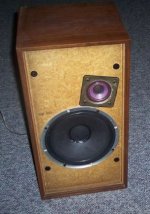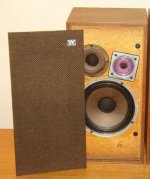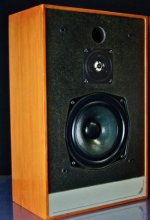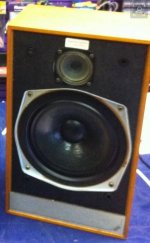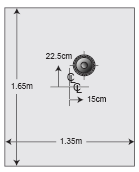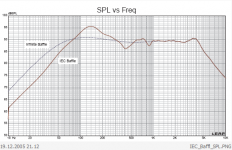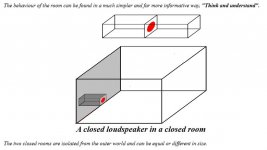The cone + dome has certainly become the dominant design approach… imagine over a million Dynaco A25!
dave
dave
Gilbert Briggs managed Wharfedale Wireless Works up to his retirement in 1965 and this event, in my opinion, brought to an end the classic era of Wharfedale loudspeakers.
Although Mr Briggs no longer had a direct hand in their development, his reputation ensured that the popularity of Wharfedale speakers continued to grow.
The mass market models of the 70s, such as the Denton, Linton and Dovedale, are now regarded as classics in their own right.
Although Mr Briggs no longer had a direct hand in their development, his reputation ensured that the popularity of Wharfedale speakers continued to grow.
The mass market models of the 70s, such as the Denton, Linton and Dovedale, are now regarded as classics in their own right.
I thought those links I posted by Ken Kessler and Brigg's grandson were interesting and informative, I presume you didn't agree, but let's move on.
Here's a couple of variations on the Wharfedale Linton theme around the 1970's. That cone tweeter in a little plastic stuffed enclosure about the size of a coffee cup. Lowish second order 1.2kHz crossover on the two-way, IIRC. Simplistic stuff on the three-way too. But it worked.
Wharfedale were not the only game in town at this time. People liked Mordaunt Short Pageant and Carnival with 2nd/3rd order filters too. My own efforts are more on those lines these days. That's an Isophon KK10 mylar dome tweeter in the Pageant if my eyes don't deceive me. It was a popular candidate for modification by Chartwell speakers and had a nice sound. The Carnival looks a bit like that old Peerless cone tweeter, but it could be a SEAS.
I do think it is futile to discuss what sounds best, be it various tweeters and types of filter topology. All we can really say is that they do different things. And just perhaps. IMO, that it is worth looking at the impedance a driver sees looking back down the filter, which determines voicecoil and cone damping. Surely a factor. Most of my best sounding filters have a lowish output impedance at the driver.Gilbert Briggs tested an assortment of the tweeters that had "made an appearance" at the time of writing of his book.
They included a Janzen electrostatic, an Ionophone plasma unit, an REC ribbon, a Goodmans pressure unit, and his own Wharfedale 3" paper cone with foam surround.
He was "amazed at the differences which were exposed" on test and wrote "So it must unfortunately be admitted that we are still some distance away from general perfection."
Plus ca change . . .
Here's a couple of variations on the Wharfedale Linton theme around the 1970's. That cone tweeter in a little plastic stuffed enclosure about the size of a coffee cup. Lowish second order 1.2kHz crossover on the two-way, IIRC. Simplistic stuff on the three-way too. But it worked.
Wharfedale were not the only game in town at this time. People liked Mordaunt Short Pageant and Carnival with 2nd/3rd order filters too. My own efforts are more on those lines these days. That's an Isophon KK10 mylar dome tweeter in the Pageant if my eyes don't deceive me. It was a popular candidate for modification by Chartwell speakers and had a nice sound. The Carnival looks a bit like that old Peerless cone tweeter, but it could be a SEAS.
Attachments
Hi Steve!
I was familiar with the content of your other links and consequently overlooked your Gilbert Briggs link.
I now see that this link leads to kenkessler.com and 'Raymond Cook's Last Interview'.
Mr Cook gives a fascinating insight into Gilbert Briggs' skills and the interview is recommended reading for all Briggs fans.
Thanks for bringing my attention to it!
I was familiar with the content of your other links and consequently overlooked your Gilbert Briggs link.
I now see that this link leads to kenkessler.com and 'Raymond Cook's Last Interview'.
Mr Cook gives a fascinating insight into Gilbert Briggs' skills and the interview is recommended reading for all Briggs fans.
Thanks for bringing my attention to it!
Recently, there has been great interest in ribbon tweeters with many loudspeaker systems so equipped coming on to the market.
Manufacturers may like to present the ribbon tweeter as the 'new kid on the block' but, as the audio veterans among us will know, the original patents for ribbon speakers date back to the early 1920s.
In his book 'Loudspeakers', Mr. Briggs refers to the low sensitivity, limited excursion and fragility of ribbon speakers. However, he admits they are capable of giving excellent results at high frequencies.
Modern materials and computer aided design have now brought affordable and reliable ribbon tweeters into the mass market, challenging the position of those hitherto dominant domes!
Manufacturers may like to present the ribbon tweeter as the 'new kid on the block' but, as the audio veterans among us will know, the original patents for ribbon speakers date back to the early 1920s.
In his book 'Loudspeakers', Mr. Briggs refers to the low sensitivity, limited excursion and fragility of ribbon speakers. However, he admits they are capable of giving excellent results at high frequencies.
Modern materials and computer aided design have now brought affordable and reliable ribbon tweeters into the mass market, challenging the position of those hitherto dominant domes!
FWIW, my comment about the horizontal placement of the B139 ABR on the 104 is not intended for the ABR itself but for it defines the width of the front baffle and affects the B200 and T27.
As far as I know, a narrow front baffle is a good thing and if the ABR was rotated 90 degrees, a design like the Calinda and Carlton III would be reached.
As far as I know, a narrow front baffle is a good thing and if the ABR was rotated 90 degrees, a design like the Calinda and Carlton III would be reached.
...a narrow front baffle is a good thing...
Another instance where one cannot make a generalization. A counter example:

And gopefully this one too: Hawking Memorial Obelisk
dave
Re Hawking Memorial Obelisk:
By Jupiter, I missed that thread! Thanks planet10.
2001 was a puzzling movie, but what about in-wall speakers?
They've got me really baffled!
By Jupiter, I missed that thread! Thanks planet10.
2001 was a puzzling movie, but what about in-wall speakers?
They've got me really baffled!
If I may add... we have gone from analog to digital, which some think it is a downgrade in sound quality, to the compressed formats which are in some cases terrible...so the industry make advances in speaker design and the recording industry makes a regression on the progress...go figure
As Alan Parsons stated in one interview, "The recording industry has different priorities."
... but what about in-wall speakers?
You can mount them on a wall or build a wall with a cavity that you could just plug these into.
There is also Poplar which is in the same thin format that uses the Alpair 10x.
dave
Further to in-wall mounting:
Briggs suggested mounting a single full range loudspeaker in the wall between two rooms, the idea being that the front of the speaker cone would service the primary room and the rear would service the secondary room.
He did admit, however, that the high frequency reproduction in the secondary room would suffer from the masking effect of the magnet assembly!
He advised that, if the wall was thick, care should be taken to mount the loudspeaker in a way that minimises cavity resonances.
Enclosing the rear of the speaker in a box was not recommended as the speaker "does not know it is mounted in wall"!
Mr. Briggs went on to state that near-infinite baffle conditions could be obtained by mounting the loudpeaker in the door of a cupboard. Hanging clothes inside would help suppress undesirable standing waves and, for maximum rigidity, the cupboard door could be converted to a sand filled panel!
At least the above ideas may have proved easier to accommodate in the home than Briggs' favourite alternative, his 9 cu ft brick built corner reflex enclosure!
Briggs suggested mounting a single full range loudspeaker in the wall between two rooms, the idea being that the front of the speaker cone would service the primary room and the rear would service the secondary room.
He did admit, however, that the high frequency reproduction in the secondary room would suffer from the masking effect of the magnet assembly!
He advised that, if the wall was thick, care should be taken to mount the loudspeaker in a way that minimises cavity resonances.
Enclosing the rear of the speaker in a box was not recommended as the speaker "does not know it is mounted in wall"!
Mr. Briggs went on to state that near-infinite baffle conditions could be obtained by mounting the loudpeaker in the door of a cupboard. Hanging clothes inside would help suppress undesirable standing waves and, for maximum rigidity, the cupboard door could be converted to a sand filled panel!
At least the above ideas may have proved easier to accommodate in the home than Briggs' favourite alternative, his 9 cu ft brick built corner reflex enclosure!
Hi boswald!
Imagining the internal volume as a cube doesn't quite reflect the visual bulk of Briggs' corner enclosure.
Since the bricks used in the construction of the enclosure were 4.5" thick, the external volume substantially exceeded 9 cu ft and, of course, the structure was immovable!
The corner enclosure had a diamond shape in plan view so I won't give all the dimensions. Suffice it to say it stood 40" high externally and was around 36" wide.
OK, its contemporary the Klipschorn may have been more imposing but Briggs' brick corner enclosure was no small beer!
Imagining the internal volume as a cube doesn't quite reflect the visual bulk of Briggs' corner enclosure.
Since the bricks used in the construction of the enclosure were 4.5" thick, the external volume substantially exceeded 9 cu ft and, of course, the structure was immovable!
The corner enclosure had a diamond shape in plan view so I won't give all the dimensions. Suffice it to say it stood 40" high externally and was around 36" wide.
OK, its contemporary the Klipschorn may have been more imposing but Briggs' brick corner enclosure was no small beer!
I have heard most of the British classic speakers; Voigt Domestic Corner Horn, Quad ESL 57, LS3/5a, BC1 etc. The only one that I would really like to hear now is the Wharfedale SFB. Just the suggestion of it's potential that one can get on YouTube confirms my belief that it could be really good.
Hi midrange!
Ah yes, ye olde sand filled baffle! Never been fortunate enough to hear one myself.
In 'Loudspeakers', Briggs gives details of an SFB suitable for home construction. I'll repeat the details here for anyone who has never read the book and would like to experiment!
He states that the main speakers could be 12" and 10" units wired in parallel, preferably with resonances below 40Hz. However 15"/10" and 15"/8" combinations are also possible.
The overall baffle dimensions are 30" high by 36" wide with supporting side cheeks that are 9" deep at the base, tapering towards the top (with hand-holes for lifting!).
A plain middle section of width 14" is used in the 12" version. Only the outer sections, each of width 11", are sandfilled. For a 15" version read 16" and 10" respectively.
The main baffle is a single 30" x 36" sheet of 1/2" plywood. The outer sections are formed by sandwiching 1/2" of dry sand between the rear of the main baffle and side sheets of 3/8" plywood.
If you've read this far then you must be really keen on SFBs, or are a just a glutton for punishment!
Ah yes, ye olde sand filled baffle! Never been fortunate enough to hear one myself.
In 'Loudspeakers', Briggs gives details of an SFB suitable for home construction. I'll repeat the details here for anyone who has never read the book and would like to experiment!
He states that the main speakers could be 12" and 10" units wired in parallel, preferably with resonances below 40Hz. However 15"/10" and 15"/8" combinations are also possible.
The overall baffle dimensions are 30" high by 36" wide with supporting side cheeks that are 9" deep at the base, tapering towards the top (with hand-holes for lifting!).
A plain middle section of width 14" is used in the 12" version. Only the outer sections, each of width 11", are sandfilled. For a 15" version read 16" and 10" respectively.
The main baffle is a single 30" x 36" sheet of 1/2" plywood. The outer sections are formed by sandwiching 1/2" of dry sand between the rear of the main baffle and side sheets of 3/8" plywood.
If you've read this far then you must be really keen on SFBs, or are a just a glutton for punishment!
Last edited:
Thanks Colin!
The photos from Troels Gravesen's site put the flesh on my earlier dimensional ramblings!
The photos from Troels Gravesen's site put the flesh on my earlier dimensional ramblings!
I must get my SFB3 into action,only use my Oris150 horns at the moment but I like collecting old stuff.
Huge Sand-filled baffles are a thing of the past, IMO. Whatever they do, they are domestically intolerable. No WAF, you see. 😀
It's why people liked the closed-box Wharfedale Linton at a tolerable cubic foot, and it got many things right elsewhere:
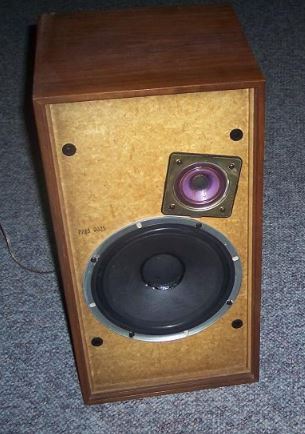
It's interesting to compare the SFB to your classic IEC measuring baffle. We all should, of course, understand room acoustics. The box and the room are interchangeable to a certain extent. What more is there to say? I'd rather talk about drivers.
It's why people liked the closed-box Wharfedale Linton at a tolerable cubic foot, and it got many things right elsewhere:
It's interesting to compare the SFB to your classic IEC measuring baffle. We all should, of course, understand room acoustics. The box and the room are interchangeable to a certain extent. What more is there to say? I'd rather talk about drivers.
Attachments
- Status
- Not open for further replies.
- Home
- Loudspeakers
- Multi-Way
- 70th Anniversary of 'Loudspeakers' by G A Briggs
